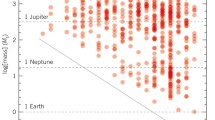Abstract
The Space Telescope can play a key role in searching for and investigating the contents of extra-solar planetary systems. For about 90 nearby stars, positional variations due to major planets would be well within the astrometric capability of the Wide-Field/Planetary Camera system. Since the centroids of star images will be determined to within a milliarcsecond down to 22nd magnitude, there will be an abundance of reference stars at very small angular distances from each planetary system candidate, and they will have small enough motions of their own to provide a reference frame of the stability required.
Similar content being viewed by others
References
Gliese, W.: 1969,Catalogue of Nearby Stars, Verlag G. Braun, Karlsruhe.
Jefferys, W. H.: 1979,Celest. Mech., in press [this volume].
Author information
Authors and Affiliations
Rights and permissions
About this article
Cite this article
Baum, W.A. The ability of the Space Telescope to detect extra-solar planetary systems. Celestial Mechanics 22, 183–190 (1980). https://doi.org/10.1007/BF01228805
Issue Date:
DOI: https://doi.org/10.1007/BF01228805




